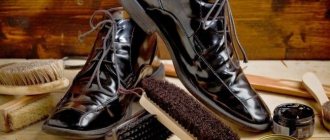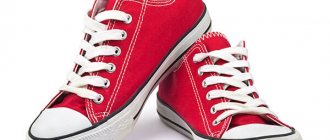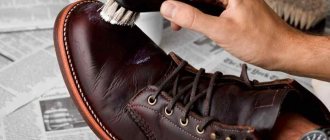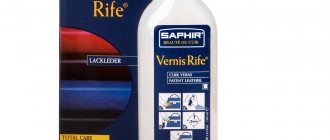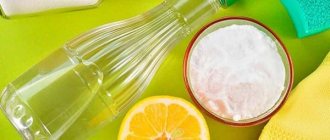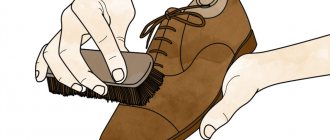Shoes and boots made of oiled/oiled leather can boast of durability and a high degree of practicality, but this does not mean that you can not take care of them. If you want such shoes to last as long as possible, so that they retain their stylish appearance for many years, you need to treat them with due attention. In this article we will talk in detail about how to care for shoes and boots made of oily leather.
Paraboot derby in oiled leather
How to care for shoes after purchase
Yes, yes, shoes need proper care immediately after they arrive in your home. While the shoes or boots are new, soak them with thick cream - this will make the leather softer and more elastic, will not dry out during storage, and will fit well on your feet during the first walk. In addition, this way you will protect open skin pores from the penetration of reagents or salt crystals, which city authorities generously use to treat sidewalks in icy conditions. If you start caring for your leather shoes from the very first days, you will get a soft, comfortable pair that will faithfully serve you for several seasons.
Results
In general, as you probably understand, there is nothing complicated in caring for shoes, the main thing is to follow the correct sequence and use high-quality cosmetics, and not black sponges with silicone from some average store. If you wear classic shoes, then you should look towards Kelly's or Saphir cosmetics. If your wardrobe is dominated by boots and just shoes made of durable utilitarian leather, then it is better to purchase Huberd's cosmetics or the shoe brands' own products.
The material was prepared by Alexander Yufa.
General tips for caring for leather shoes
- Be sure to break in new leather shoes before leaving home for the first time. This way you will be more comfortable, and the recently purchased pair will stretch not in rain or heat, but at room temperature.
- To maintain its shape, use special wooden or plastic blocks for storage. This will help avoid creases and subsequently cracks.
- As a preventive measure, lubricate the line connecting the sole with the upper with a protective agent - this will prevent leakage.
- Alternate several pairs of shoes (at least two). This way it can dry naturally.
How to properly store leather shoes
To ensure that seasonal shoes retain their properties and appearance during three to four months of storage, thoroughly rinse and dry the products. Carefully lubricate the material with cream and leave to soak overnight.
After this, fill the inside of the shoes or boots with newspapers to maintain their shape, put them in a cardboard box and store them. For storage, it is better to use boxes with holes for air circulation so that the skin “breathes”.
Experts note that it is better to store shoes at room temperature and low humidity, away from radiators, heating devices and sunlight. How to store shoes correctly and compactly, read here.
If after off-season storage the skin is dry, you can use any vegetable oil to restore its properties. But the best option is castor oil. You just need to lubricate the material with the product and let it dry.
What you need to care for your shoes
First of all, stock up on cleaning “equipment”, which includes a shoe brush (different for each shade of cream), an impregnation sponge, a set of polishing cloths, a washing sponge, a soft rag or napkin and a toothbrush. Pay attention to the quality of the brushes - the bristles should be moderately soft, otherwise you risk scratching the natural skin.
Special leather shoe care products available for sale:
- shampoos and foams remove dirt well and retain color;
- creams extend the life of shoes, make the leather soft and elastic;
- polishes neutralize the negative effects of moisture and give a natural shine;
- impregnations help neutralize salt solutions and protect against moisture.
Its spectrum of action directly depends on the composition of the product. A high concentration of fats and oils gives shine and moisture, silicones do a good job of polishing the surface, solvents remove dirt, and thanks to wax, demi-season and winter leather shoes look more well-groomed.
Specific cosmetics are intended more for shoe owners: deodorants eliminate unpleasant odors, anti-colors protect socks and tights from staining, and stretch marks help stretch a tight pair in a matter of hours.
A material for shoes better than genuine leather has not yet been invented. High-quality leather is very pleasant to wear, it fits perfectly on the leg, and stretches a little in the right places. In leather shoes, if they are appropriate for the weather, a good microclimate is created - the feet do not freeze, do not sweat, and feel very comfortable. It is not surprising that according to statistics, more than 60% of buyers choose shoes made from smooth genuine leather. In addition, leather is practical and does not require labor-intensive care.
But this does not mean at all that you can wipe your shoes with a cloth once every six months and stop there ☺. Just like the skin of your face and body, the material of your shoes needs care. Regular care will extend the life of your favorite pair for a long time and make it neat and shiny, as if it had just come from the store.
What you should pay attention to before purchasing
Select shoes that are exactly the right size and fit. Shoes that are too tight will stretch excessively and ruin the leather, not to mention cause discomfort. And if the model sits too loosely, then when walking, folds and creases will begin to form on it.
Before putting on your shoes for the first time
Before wearing a new pair for the first time, you need to select a water- or dirt-repellent agent suitable for natural leather and treat the leather in accordance with the instructions. After drying, clean with cream.
Daily care of leather shoes at home
The best time to take care of your shoes is as soon as you get home. If this is not done, then over time difficult to remove stains will appear, the color of the skin will deteriorate, and cracks will form.
After each time you go outside, wipe your shoes with a dry cloth if there is only dust on the skin, or with a damp cloth if it is heavily soiled. Start washing from the heel, then clean the sole and then the upper material. After washing, you need to wipe the pair thoroughly with a soft cloth to remove excess moisture. Otherwise, the shoes will take a very long time to dry.
The second stage is drying.
Under no circumstances use heat sources - radiators, heaters, hot air hair dryers. Yes, they dry quickly, but this comes at a price in the form of stiff, warped skin.
You need to remove the insoles, stuff the shoes with paper or put mold holders inside and dry them at room temperature. Then your shoes or boots will retain their beautiful shape for a long time without creases.
Drying takes quite a long time, and therefore it is not recommended to wear the same pair every day. Shoes and lining should rest and straighten out, only then you will be comfortable and warm.
And finally - cream
A dry and clean pair should be treated with cream so that the leather remains elastic, soft and shiny.
Apply the cream in a thin layer using a shoe brush and carefully spread over the entire surface. Then, after a few hours, when the cream is absorbed, wipe off the residue with a dry cloth and polish the skin with a soft cloth.
The cream is matched exactly to the color of the shoes, so you should think before purchasing what kind of care product you will use.
In the store it is easy to choose black, brown and the most versatile - colorless cream. There are other colors on sale, but it can be difficult to find the right shade.
If necessary, additionally treat the pair with water-repellent sprays.
Rules for caring for leather shoes in autumn and winter
In winter and autumn, the load on shoes increases. There’s just so much on our Russian roads - slush, water, sand, reagents...
It is especially important to clean your shoes immediately after returning from the street, so that harmful substances do not have time to be absorbed. It is necessary to treat the pair with a water-repellent agent at this time of year much more often - once every 4-6 days or as necessary.
Skin care products
Just like cosmetics, the choice of shoe care products is now simply endless. The choice depends only on your desire and budget)
Of course, you can’t do without basic care - cream, brushes and water-repellent products.
Creams are thick, suitable for thick leather on demi-season and winter shoes, and more liquid, intended for delicate dress and summer shoes.
And there are plenty of other means:
- Sometimes, at first, shoes, especially brightly colored summer ones or unlined ones, stain your feet. The reason is that genuine leather is a porous material that absorbs dye well, but easily releases it back. You can avoid staining if you use harsh and not at all useful fixatives in production, which will then touch the skin of your foot, but responsible manufacturers choose a different path. Special aerosols “Stop-Color” or “Anti-Color” will help you cope with this situation more environmentally. Treat the inside of the shoe and let dry.
- For more gentle cleaning of shoes, you can use special cleaning foams instead of water.
- Restoring paints, which come in the form of a liquid, cream or spray, can help restore the color of shoes or disguise scratches or abrasions.
- You can make your shoes shine using glosses or polishes.
How to properly care for white leather shoes
The fashion for white shoes regularly returns, and despite the difficulties of care, we, of course, cannot resist buying... Almost everyone has white sneakers or sneakers.
Light skin is more demanding - stains easily remain on it, and they need to be removed immediately, then this will be much easier. Such shoes should not be left in the sun. Gradually, during wear, the leather loses its whiteness, so to the arsenal of shoe cosmetics you need to add an eraser for cleaning the soles and special products for cleaning white leather, which will help restore the desired shade.
There are also popular tips - toothpaste, micellar water, melamine sponges. They work, but be careful and always test the method on an inconspicuous piece of skin first.
Leather quality
High-quality leather will last much longer, so pay attention to shoes from trusted manufacturers.
The collection of the German brand Caprice presents products from the best types of genuine leather with various properties:
- nappa with a smooth, uniform surface.
- Soft Leather - leather from sheep raised in the vast expanses of Central Africa. This leather is fantastically soft and pleasant to the touch.
- Deer leather is incredibly elastic and durable. It fits your foot like a second skin. It stands out for its characteristic large structure.
Storage
It is better to store shoes in a dry, dark place. Moisture, wind, and sun rays are destructive to shoes. Before seasonal storage, each pair must be thoroughly cleaned, dried, lubricated and ventilated, and then tightly stuffed with paper or wooden spacers placed inside.
Let your shoes always be perfect!
How to clean shoes from water and dirt
Moisture and dirt are destructive to natural leather, so immediately after a walk in bad weather, take proper care of your leather shoes. First, clean the outside using a damp cloth or rag. Start at the top and then work on the heel and outsole. Wipe the shoes dry and leave until completely dry. Do not use a hair dryer, radiator or special dryers for this - this will cause the skin to dry out and become deformed. Finally, apply a thin layer of cream to the surface and leave it to absorb for 2-3 hours. Before going outside, treat your shoes with a water-repellent spray and polish until a characteristic shine appears.
Don’t worry if a colored pair of shoes darkens under the influence of moisture - after drying, the “native” shade will be restored. By the way, a change in color in such cases is a sure sign that this product is made of natural material.
Suede shoes are not recommended to be worn in rainy weather, since with each wetness their surface becomes more and more difficult to return to its original appearance. If you still cannot avoid contact with moisture and dirt, treat it with soapy water and then dry it over hot steam. Cloudy stains can be washed off from a pair of varnish without much effort, but do not forget to rub it with glycerin or a special product afterwards.
Handle white shoes with care: dirt and dust easily settle in the slightest cracks and scratches on their surface, and you should not use aggressive substances for cleaning. Use a special shoe shampoo, a soft brush and a polishing cloth. The white sole can be easily cleaned with a toothbrush or just a small brush.
Features of care for different types of skin
Today, manufacturers produce huge quantities of shoes not only from genuine leather, but also from its artificial budget analogues. It can be leatherette, eco-leather, matte or patent leather. The method of caring for shoes made of light leather is also discussed separately.
Eco leather
Eco-leather is an artificial analogue of leather on a cotton basis, the material is hypoallergenic, soft, elastic and with good ventilation properties. In fact, caring for eco-leather shoes is supposed to follow the same routine, but with some differences. Experts admit that eco-leather looks much more attractive and respectable than leatherette.
Care involves the following actions:
- removing dirt with a soft cloth soaked in warm water;
- natural drying;
- impregnation of the material with a protective water-repellent cream, spray or aerosol;
- removing difficult stains with special cosmetic cleaners for leather products.
Eco-leather is more resistant to any external influences and bad weather, but this does not mean that care can be carried out less frequently and less responsibly. If you take proper care of your shoes, it will be quite difficult to visually distinguish them from shoes made of genuine leather.
Leatherette
Faux leather is an artificial leather that is similar in appearance to its original, but only in appearance. As practice shows, this material is not flexible, that is, it does not stretch well, does not allow the skin of the legs to “breathe,” and is also weak to temperature changes. Accordingly, no matter what care you take for artificial leather, shoes will still last much less than models made from natural material.
Caring for leatherette shoes involves several points:
- remove dirt with a soft cloth soaked in warm water;
- remove moisture with a dry cloth and dry in natural conditions;
- treating shoe uppers with silicone-based products to give leatherette shine.
Experts note that leatherette shoes do not tolerate products containing alcohol, fats and the component acetone. Upon contact with these substances, a chemical reaction may occur, resulting in stains and stains on the surface of the shoes.
Polished leather
Separately, you need to familiarize yourself with the rules of how to care for patent leather shoes. We are talking about shoe models made of leather, but with a thin surface layer of coating, due to which the shine and mirror reflection of the material appears. This top layer is very sensitive to various influences and mechanical contacts, so care must be delicate.
Do you wear patent leather shoes?
Not really
So, caring for patent leather requires the following actions:
- cleaning from dust and dirt should be done with a cotton swab or soft cloth soaked in milk;
- polishing shoes with glycerin, petroleum jelly or castor oil;
- use of water-based sprays and creams;
- Lubricating the surface of shoes with egg white to maintain the glossy shine of shoes.
Patent leather shoes look festive and solemn only if they are subjected to constant competent care using specialized cosmetics.
Matte
Shoes made of matte leather are those that do not have a mirror shine or lint; they look strictly, laconic and elegant. But to maintain its aesthetics and service life, proper care is essential. It is based on three pillars - cleansing, nourishing and protecting smooth leather shoes. More details about each stage below:
- Cleaning – in case of heavy contamination, you can use special cleaning foams or a simple soap solution. Finally, the shoes should be wiped dry with a dry cloth.
- Replenishment - shoes should be regularly lubricated with nourishing cream at least 2-3 times per season. The cream should be applied to a textile napkin or a small brush, rub in in a circular motion, and leave the shoes until completely dry.
- Protection - every 3-5 wears of shoes, special products must be applied to them to protect them from dirt and moisture. These can be waxes, water-repellent sprays, or beeswax-based waxes. The product is applied with a small piece of fabric in a circular motion, polished with a large brush or a nylon sock.
Light
Caring for white leather shoes requires special care and compliance with the rules. Experts primarily advise storing and caring for white leather shoes separately from colored pairs. Care consists of the following actions:
- caring for brown leather shoes (or any other color) and white shoes should be carried out at different times, with separate means and tools;
- dust and dirt should be removed with a dry cloth, then washed off with a cloth and soapy water;
- the remaining soap solution is removed with a wet sponge;
- shoes should be wiped with a dry cloth;
- Transparent or white shoe polish is applied to a brush or cloth and then rubbed over the surface of the shoe;
- You can polish your shoes with a velvet cloth.
White shoes are especially susceptible to any type of dirt and mechanical injuries, so when caring for them, it is important to be careful and delicate, and not to resort to strong friction or the use of hard fabric textures.
Caring for leather shoes in the cold season
In winter, you should take extra care of your leather shoes. At this time of year, she often gets wet and freezes in the cold, which negatively affects her appearance. Before the start of the season, wash and dry it naturally, treat it with a rich cream and a product that contains wax. After each exit outside, clean it of reagents and salts, using the recommendations from the previous paragraph. To remove pronounced stains on suede, use a brush and a regular office eraser, and wipe smooth leather with a strong vinegar solution. Before leaving the house, spray your leather with a water-repellent spray - this is an important element of caring for leather shoes in winter. And to further protect your shoes from excess moisture, and yourself from falls on slippery sidewalks, arm yourself with anti-slip pads on the soles.
We hope these simple rules will help you keep leather shoes purchased from the Respect online store in their original form for a long time.
Products for the care of boots made of oiled leather
We have compiled the following list of specialized products and accessories that are worth purchasing:
- Liquid agent for removing traces of reagents (Saphir Hiver-Winter, Tarrago De Salter);
- Fat impregnation that nourishes and protects the skin (Saphir Dubbin Graisse, Saphir Huile Protectrice are good options);
- Cleaner for removing deep stains (for example, Saphir Reno'Mat or Tarrago Oil Tanned Cleaner);
- Nitrile gloves (they should be used to protect hands);
- Saddle soap for moderately gentle cleaning (classics - Saphir Saddle Soap and Avel Savon Cuir Lisse);
- Cloth napkins for cleaning and polishing, as well as for applying grease/cream and shoe polish (to save money, you can make them yourself from old T-shirts or shirts);
- A brush for cleaning the top of shoes (quite hard, ideally with horsehair bristles);
- Top polishing brush (softer);
- Brush-applicator for applying fat/cream (optional, because it can be replaced with a cloth or even just gloved fingers);
- Brush for cleaning and greasing the welt (similar to a toothbrush).
Reptile skin
There is real reptile leather, and there is imitation calf leather. We'll talk about the first one. Alligators, crocodiles and lizards look very beautiful, but require much more attention than traditional leathers. If you are lucky enough to have your own pair of real Crocos in your wardrobe, be sure to take care of them regularly and carefully. These exotic leathers are prone to drying out and this should not be allowed to happen. Every three months, follow these steps:
Step 1
Wipe your shoes with a damp cloth to remove dust and dirt. It's always best to work with a clean surface. Wait a few minutes before moving on to the next step.
Step 2
Clean your shoes with a natural bristle brush. Reptile skin has a complex texture, so a brush will help in cases where fabric does not help.
Step 3
Reptile skin is special. Products for regular calfskin cannot be used to care for Croco leather. This can dry it out and cause cracking. It is impossible to restore cracks in such skin. So, if standard creams and waxes cannot be used, then what should you do? Reptile skin care products can be difficult to find. The Saphir range includes a special Reptan balm. Crocodile skin will greedily absorb this product, so don't be afraid to overuse it.
Apply the balm with a flannel cloth and rub it into the skin in a circular motion. The longer you do this “massage”, the better. Treat the entire shoe and leave for 5-10 minutes.
Step 4
Buff the balm over the entire surface with a brush. After this, a light glossy shine should appear.
Step 5
Want more shine? Reptiles will never be able to boast such brilliance as calf or cordovan. But even without this it won’t be boring. As a last resort, you can buff the leather with a clean flannel cloth or nylon stocking for a finish.
Smooth leather shoe polish with applicator
The cream is water-based and contains silicone.
It is absorbed very well, renews the structure of the material, maintains the softness of the skin, and prevents drying and cracking. The cream is easily removed from clothes and hands. Directions for use: Apply a small amount of cream using an applicator to clean and dry shoes. Let it soak in for 15 minutes and remove excess cream with a dry cloth. You can use a brush to polish your shoes. Apply the cream only to clean shoes, because... Dirt accumulates in the applicator, which can ruin your shoes. You can use the cream at any frequency.
Suede
Suede - there is no other material like it. You will see the difference immediately when you touch it. What you lose in durability with this material is what you gain in texture and softness. Suede has a distinct style and while formal shoes are also made from suede, I think it works better with loafers, chukkas and boots. The only drawback is that suede collects stains.
It is also difficult to clean. Read how:
Step 1
If your suede shoes are light-colored, then stains are inevitable. For dirt this deep, you'll need a suede eraser to help "loosen" the stain. Rub the eraser over the stains. This is unlikely to remove them completely, but the skin will be ready for further cleansing.
Step 2
Remove eraser crumbs and other dry dust and dirt with a brush, then use suede shampoo. Saphir Omnidaim is suitable for this task. You will only need a small amount of this product. I recommend diluting it with warm water in a ratio of 1:3. Prepare the bowl and brush that comes with the cleaner.
Note: Some people use vinegar and water instead of shampoo, but I feel more comfortable using products specifically formulated for this purpose.
Step 3
Apply Omnidaim to the leather and clean the boots in a circular motion. There will be foam when you start. Pay more attention to the areas you worked with the eraser. To prevent water from washing away the dye, try to keep your shoes evenly damp (if that makes sense) and clean your shoes as quickly as possible.
Step 4
Rinse with shampoo. Someone will say that you can wash your boots under the tap. This is difficult for me, because water can get inside the shoes. If you feel more comfortable this way, try to protect the inside of your shoes from water. I rinse the brush, then change the cup with warm water. Then I clean the shoes with this brush until the foam stops appearing.
Step 5
The hardest part is over. Now the shoes need to be allowed to rest. If you don't have wooden mold holders, stuff the shoes with newspaper and lay them on their sides. Let the shoes dry completely. It's better to leave it overnight.
Step 6
Your shoes may look boring. Don't worry, everything is fine at this stage. The nap on the suede has become flat, so the shoes look bad. You can raise the pile using a crepe brush or a brush with metal bristles. This procedure will revive your shoes.
Step 7
Have you noticed that there are problems with color too? Here you can use a suede repair aerosol. I recommend Saphir Renovetine. A perfect color match is not necessary, but it should be close. There is also an effective tool that can be added before touching up. Light steam restores suede very well. Point the steamer at the shoes from a distance of 25-30 cm. You will not wet the shoes, but will only warm them up. It is safe.
Step 8
Finally, apply a suede treatment to your shoes. Saphir or Tarrago impregnations are suitable for this. This will help protect your shoes from water and stains. Common sense says that you shouldn't wear suede shoes in the rain. But you need to be prepared for the unexpected. Spray the impregnation evenly from a distance of 20 cm. Apply once a month. Depending on the season, you can do this more often.
Drying shoes
Wet shoes are unpleasant. And if you get caught in the rain, then drying your shoes immediately upon arriving home is your main responsibility. Special spacer inserts, sachets of silica gel (these are included in every shoe box) or, the old-fashioned way, newspaper balls will help you here. In general, experts advise drying your shoes for at least a day after each wear - the moisture released by the feet negatively affects the condition of the shoes, and therefore it is better not to wear one pair of shoes every day, letting them “rest.”
Outsole protection
Most well-known companies - John White, Cheaney, Loake - use vegetable tanned leather to make soles. Of course, this is very convenient, but it wears out quite quickly. Place a rubber outsole - this will protect the sole and make it less slippery, this is especially true for autumn boots.
Rubber outsole
Smooth leather shoe polish with applicator
The cream is made on a water basis, it is absorbed very well, renews the structure of the material, maintains the softness of the skin, and prevents the formation of creases. The cream is easily removed from clothes and hands. Volume: 75 ml; color: black, brown (3 shades), neutral. Directions for use: Apply a small amount of cream using an applicator to clean and dry shoes. Let it soak in for 15 minutes and remove excess cream with a dry cloth. You can use a brush to polish your shoes. Apply the cream only to clean shoes, because... Dirt accumulates in the applicator, which can ruin your shoes. You can use the cream at any frequency.
Additional Tips
- You should not often use colorless cream for care; high-quality products are usually sold in salons, where, when paying for your purchase, they will recommend that you purchase care products at the same time, which is very convenient;
- white stains will not appear on shoes if they are treated with colorless cream and polished.
- It is impossible to say with 100% certainty that a new pair of shoes necessarily needs primary treatment to protect them from external adverse influences. This applies only to products made of nubuck and suede. Leather products undergo all necessary protective stages at the production stage.
Rules for storing shoes
Leather shoes should not be stored in plastic bags. Use cardboard boxes for this. Ideally, this is the “original” packaging – the one in which it was purchased.
Send the prepared product for storage: wash and dry boots and shoes, apply cream generously, insert pads or crumpled paper inside so that they do not deform.
Proper care and storage of shoes made of genuine leather will pay off and ensure waterproofness, softness and elasticity of the products and a long service life.
Shell Cordovan
Nick Horween (of the famous Horween Leather Company tannery) once said this about Cordovan: “It’s like having a fine wine that you can drink every day and only get healthier.” Okay, Mr. Horwin. Made from the back of horsehide, Cordovan can last for decades. This is very expensive and difficult to produce leather. The processes of tanning, fatliquoring, trimming and polishing take more than six months. The price is scary, but this material is worth every penny.
Step 1
Remove the laces and wipe the shoes with a damp cloth. Sometimes white stripes appear on the folds. This is fat and needs to be removed before leaving.
Step 2
Brush to remove dust and warm the skin.
Step 3
Apply balm to hydrate leather and provide a base for polishing. Again we recommend Saphir Renovateur. Spread a small amount of balm over the boot using a cotton, suede or flannel pad.
Step 4
This move has long been discussed among experts. Those who follow the Mac Method claim that Cordovan only needs to be polished on rare occasions (no more than once every 20 wears). At this point, they will tell you to vigorously brush your boots until your “arms fall off.” 5-6 minutes for one half-pair is enough. In this tutorial, we'll skip the waiting time and move on to polishing.
Step 5
No cream? This is not necessary. Cordovan has very small pores; for this he is revered. That is, in this case, the use of cream will prevent the appearance of shine. There are creams specifically created for Cordovan leather, such as Saphir Crème Cordovan. But from experience, the balm does this alone well. Don't worry and move straight to polishing wax. Apply a thin and even layer of wax and leave the shoes for 20 minutes.
Step 6
Brush the shoes and add water to the wax cap. Buff a drop of water and a small amount of wax all over the boot and let dry for 20 minutes.
Step 7
Repeat the previous step, but use about half as much wax.
